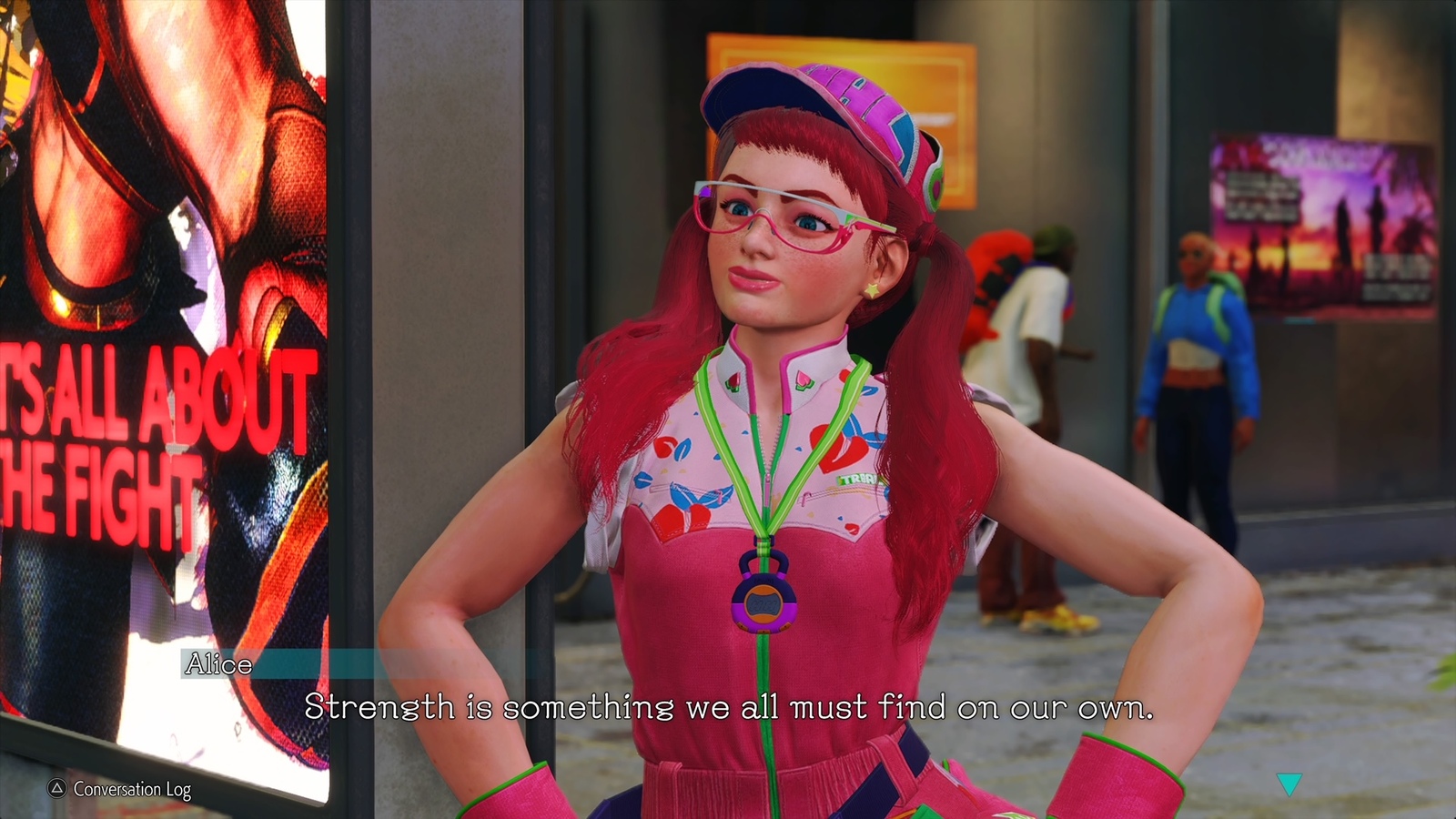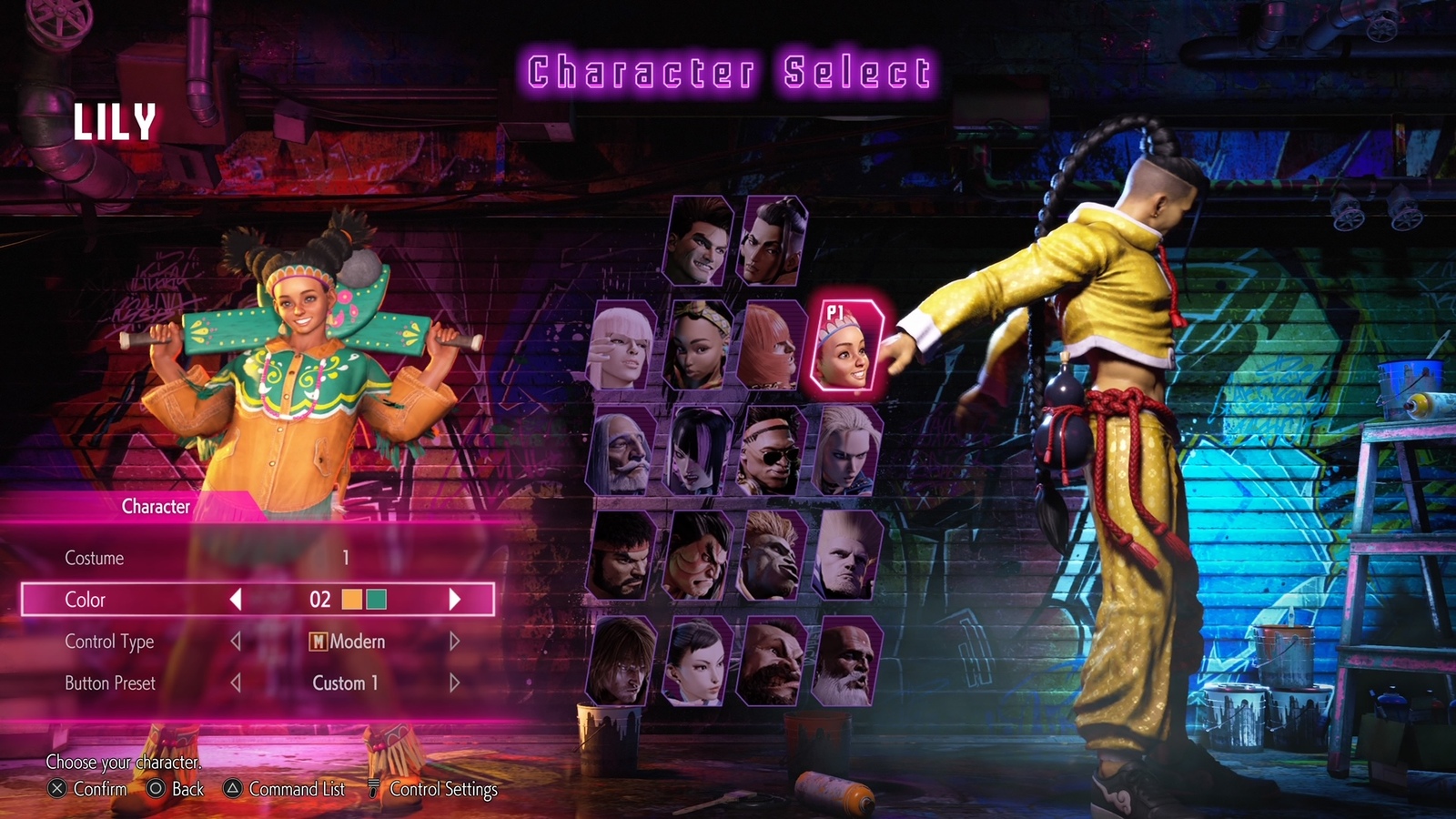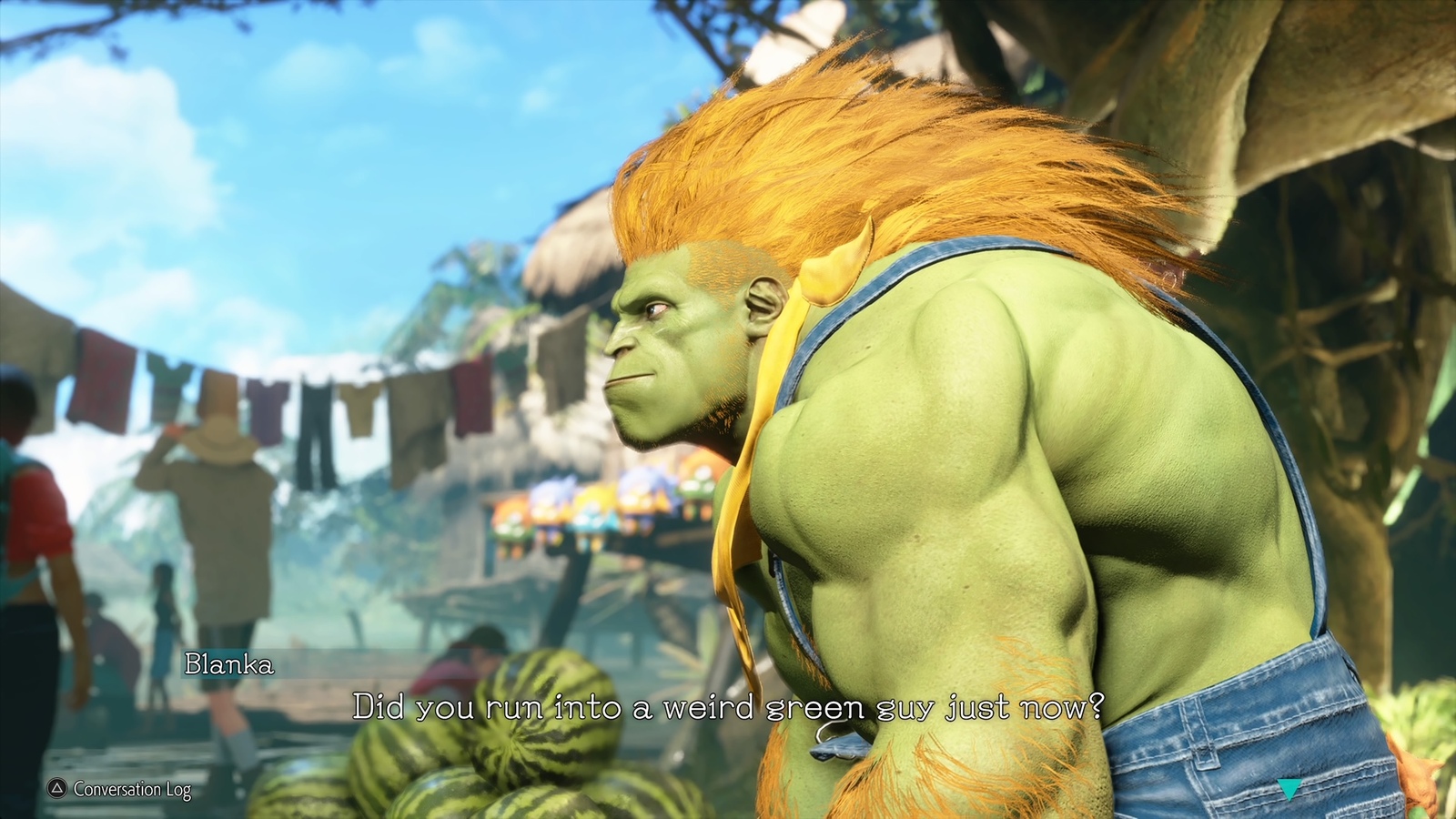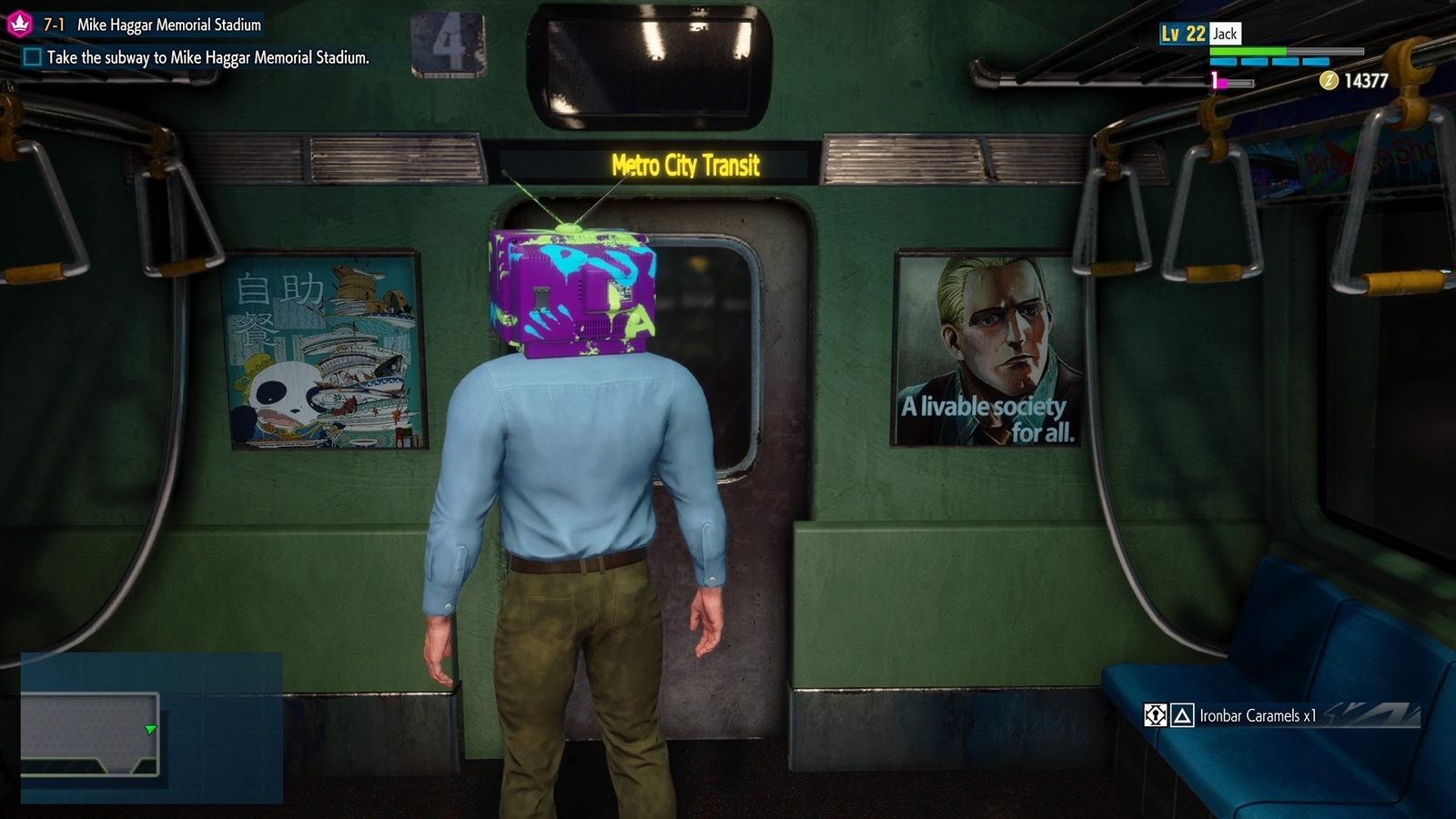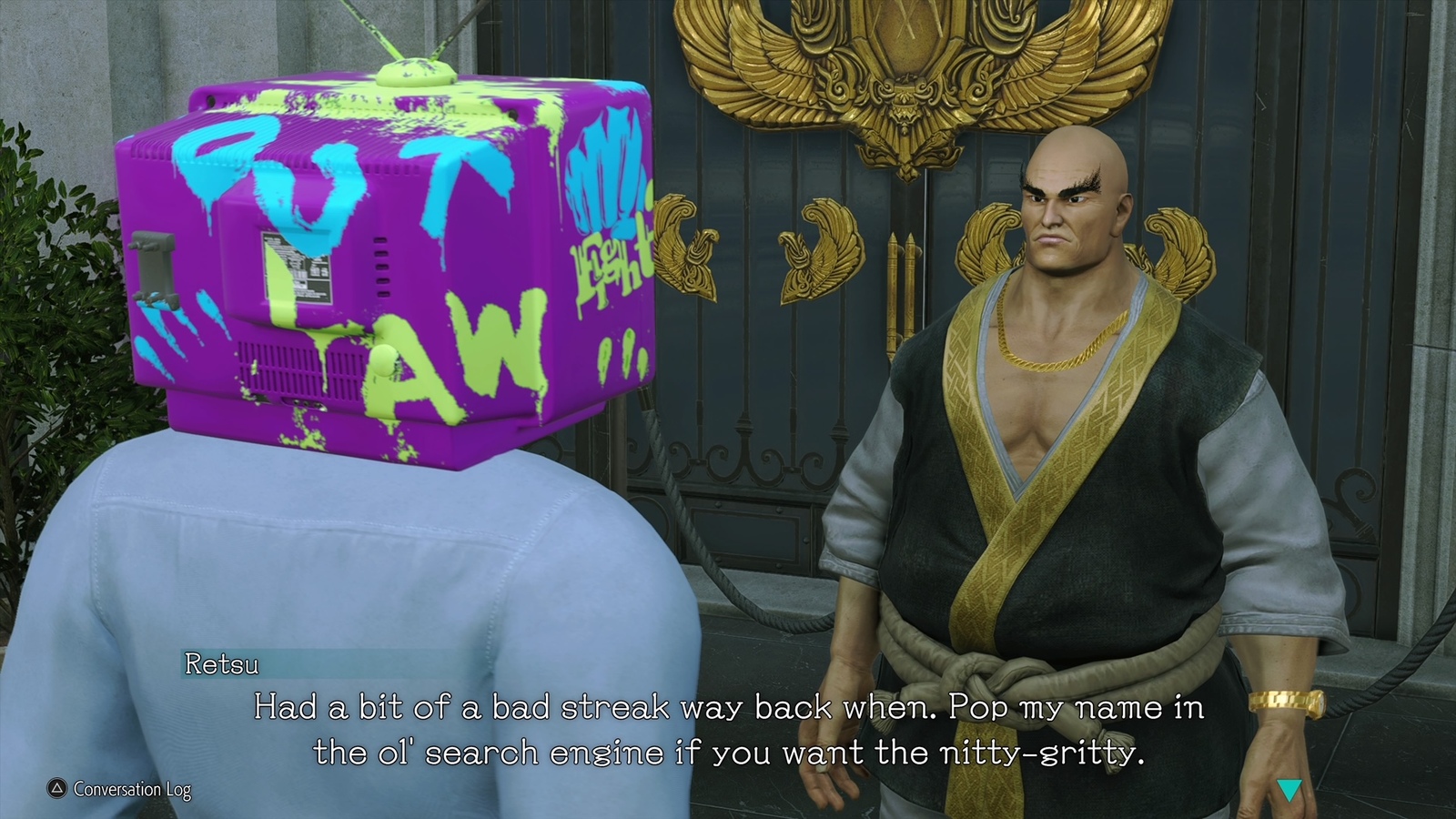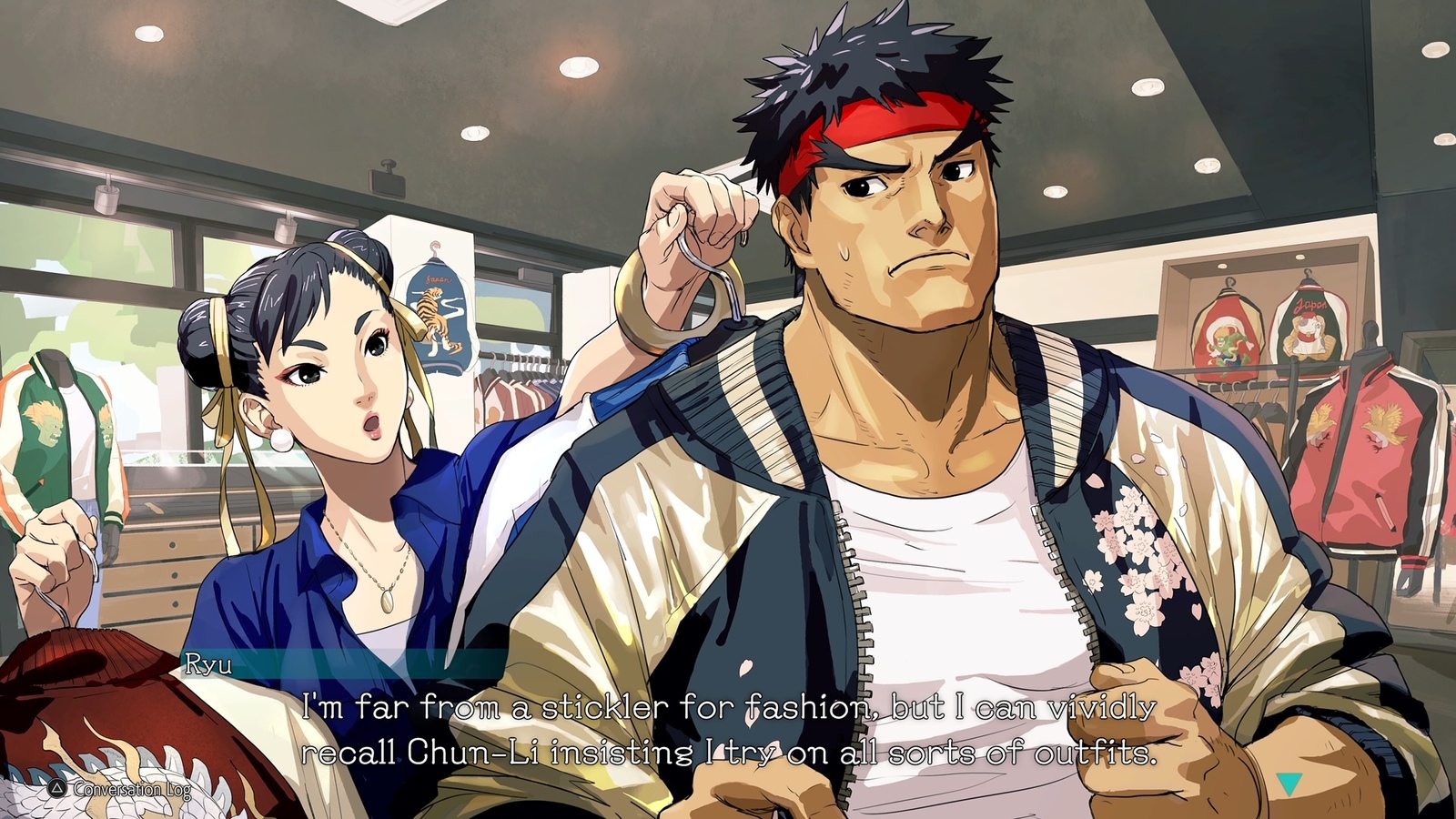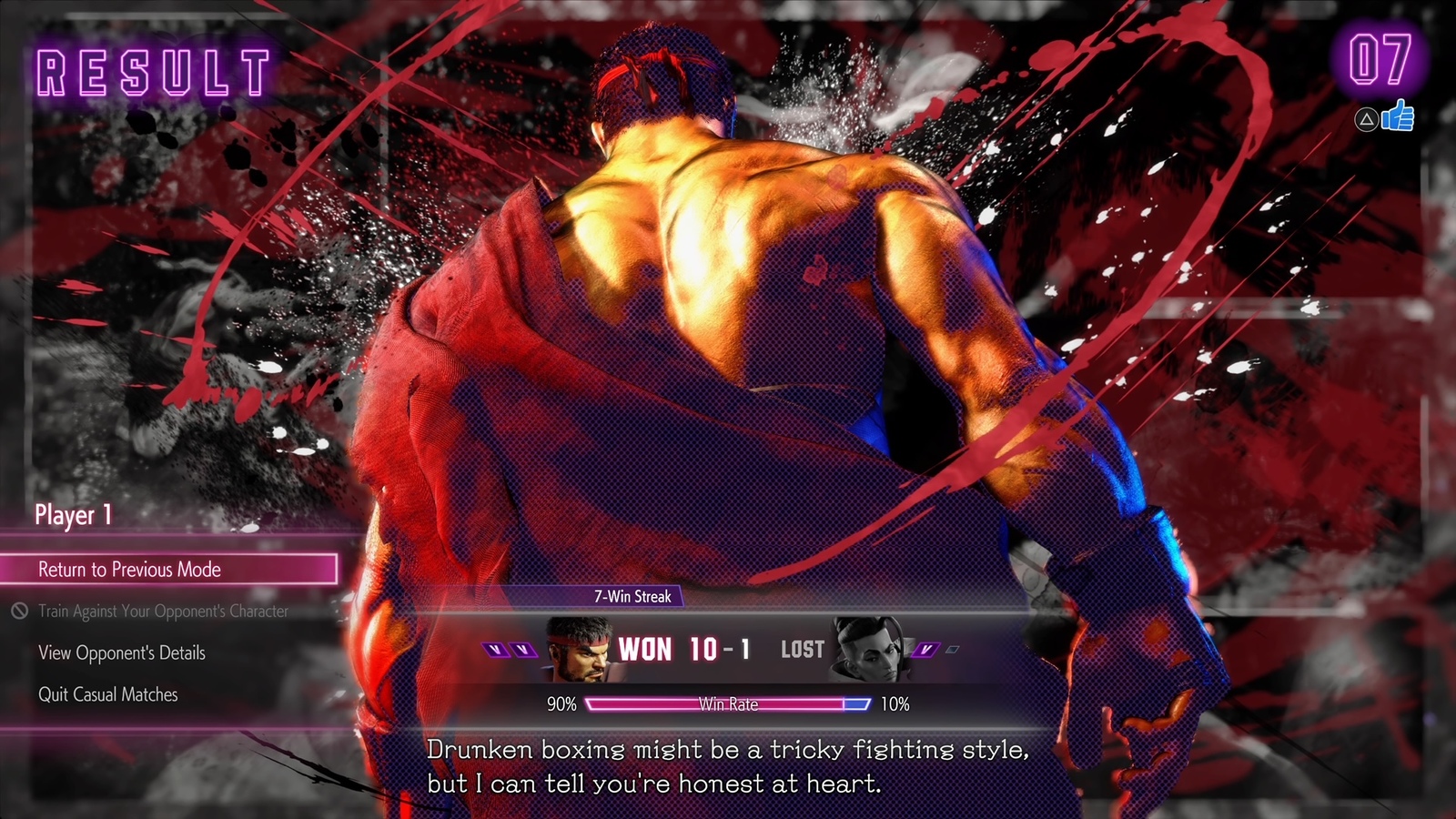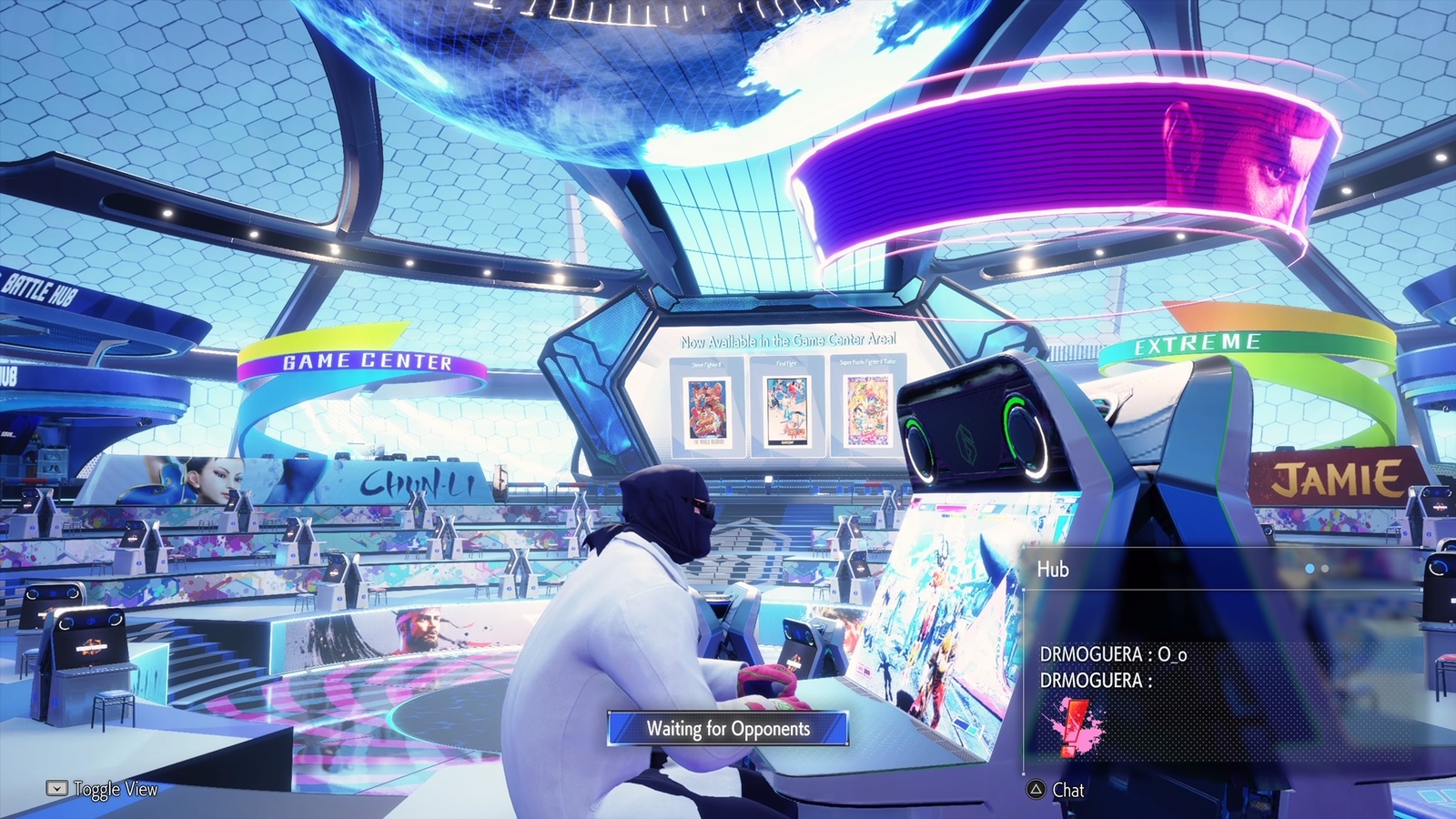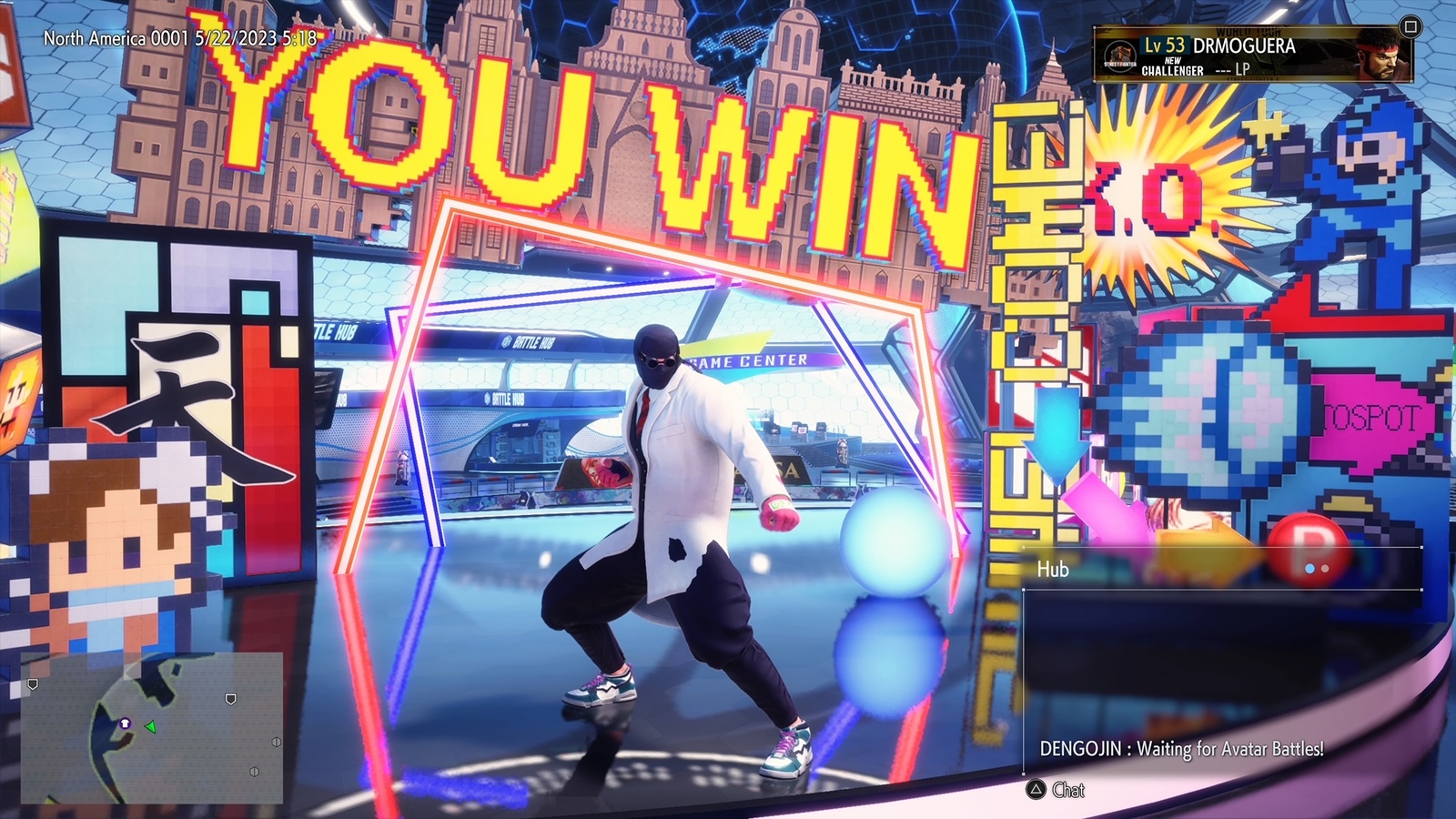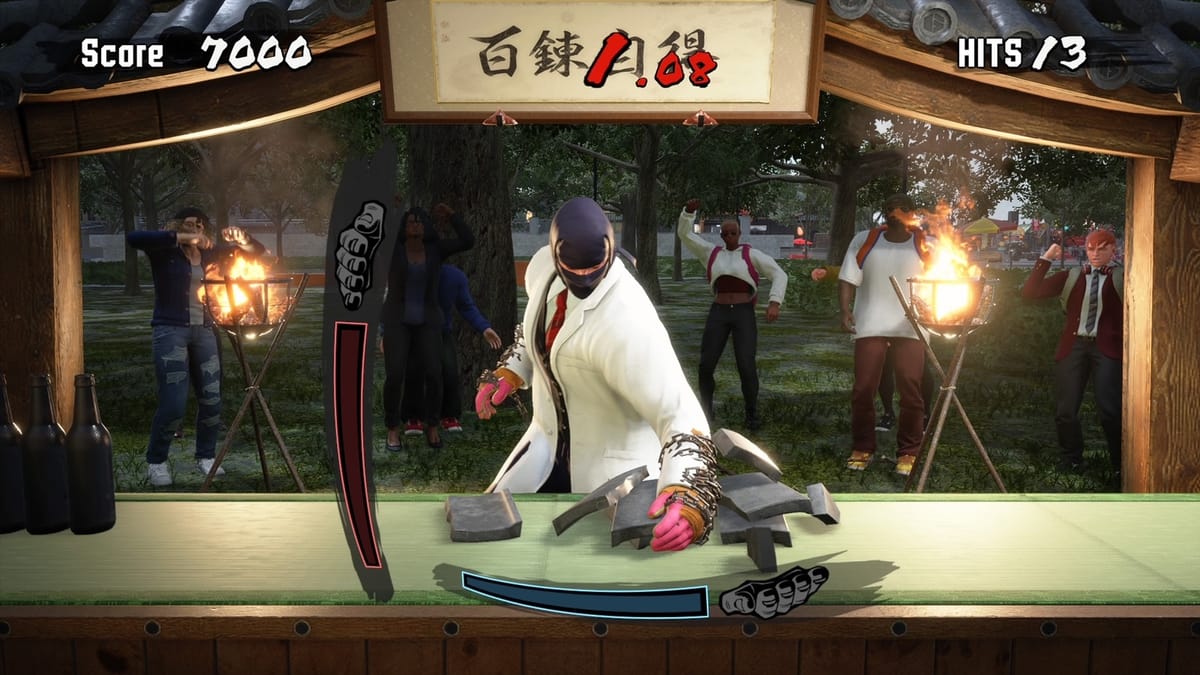
Street Fighter 6 is a world-spanning game in more ways than one; too big for just one perspective! Editors Jack Zustiak and Abdul Saad have formed a tag-team duo to bring you the most comprehensive review on the streets. First, Jack will discuss the game in broader terms, and then Abdul will focus attack the online modes.
Jack – The World Tour Warrior:
Street Fighter 6 asks its players a simple question: what is strength? It’s the perfect question for a fighting game due to the subject matter alone, but it’s also a poignant one to ponder for developing any kind of skill. The question maintains an open-endedness that can result in a wide variety of answers. Street Fighter 6 excels because it recognizes the wide world of players out there with their own definitions of strength, even the people who may not know what their answer is yet. No matter where you stand on your journey, Street Fighter 6 pushes you to take your next step forward.
Everyone plays fighting games for different reasons. That may seem obvious, but it’s a fact that can be easy to forget. Competitive events, highlight clips of top players, and intimidating button inputs dominate the general perception of the genre. It’s a cutthroat world where only the strongest survive. High skill barriers and even higher skill ceilings are not all that fighting games consist of, though. In fact, seeing them purely in that way cuts out what makes them so compelling. It’s like skipping to the last chapter of a book or scrolling to the end of a review to see the score (hey, stop it!).
Fighting games epitomize the phrase “it’s about the journey, not the destination”. Reaching the top of the food chain certainly can be your final destination, but for the rest who don’t, the appeal lies in the simple art of improvement. A desire to improve can stem from a variety of different origins and grow into wildly different directions – it’s a personal journey. Your improvement may not even have anything to do with being good at fighting. No two people are likely to play for the exact same reasons or even play in the exact same way.
That principle starts with the battle system. Street Fighter 6 introduces a “Drive” system to its battles that ties a multitude of options to a single bar. In a way this system simplifies things to one major resource to keep track of, but ultimately it greatly complicates matches. Drives open up both yours and your opponent’s options from the outset, allowing both to express your playstyles from the word “FIGHT.”
Most Street Fighter games are built around escalation. Fighters start the match with their basic moveset and as they beat each other up, special meters fill that grant access to new moves over the course of the match. Street Fighter V, 6’s immediate predecessor, took this to an extreme with its V-Trigger system, which locked major components of each fighter’s playstyle behind meters. There are some advantages to this approach, particularly for newer players who can avoid being completely overwhelmed at the start of a match, but at this point I suspect most are more than happy for a fresh, less limiting ruleset.
The beginning of a match Street Fighter 6 throws that escalation-style pacing largely out the window and instead says “just do whatever you want!”. Drives offer a variety of options. At a basic level, they let you power up your special moves, so something like Ryu’s fireball shoots extra fast and hits extra hard. Their utility expands far beyond that, however.
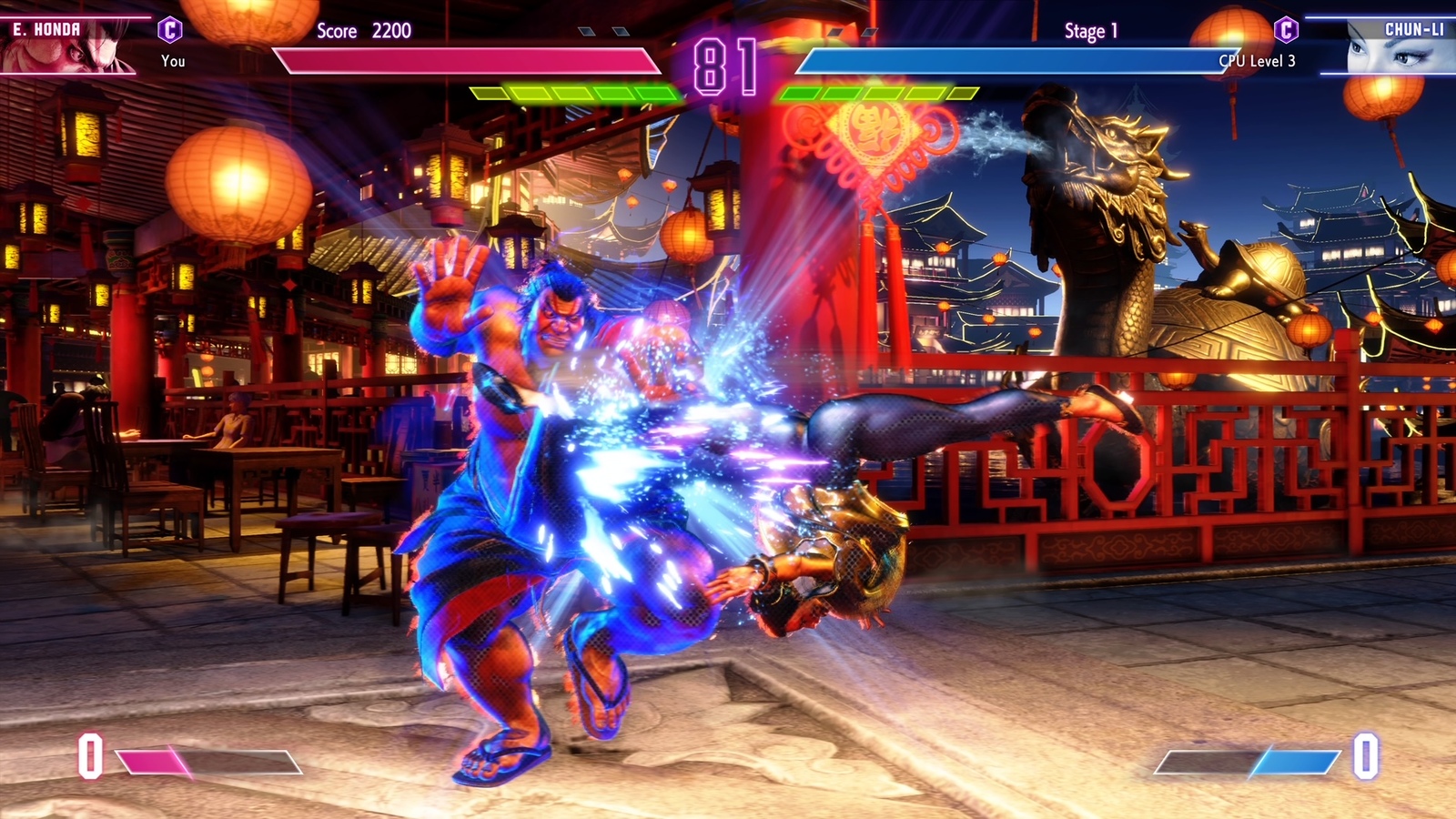
Drives give you access to overarching abilities that every character consistently has access to. The Drive Impact allows you to barrel through your opponent’s attacks, which you can use to move in on and punish players for carelessly throwing out moves. The Drive Parry absorbs attacks at the cost of meter, which can get you out of tricky situations. A perfectly timed parry puts you in a prime position to immediately counter attack. Drive Rush expands your offense by canceling out of attacks and parries to propel yourself forward, while Drive Reversal solidifies defense by pushing attacking opponents away.
The Drive moves are basically a comprehensive offensive and defensive toolset whose utility depends entirely on the player. They are not dominant forces in the exact same way parries were in Street Fighter III or Focus Attacks were in Street Fighter IV. Street Fighter 6 instead takes elements of those ideas and recontextualizes them into a system that forces you to focus on some options over others by tying them to the same meter. While the best players will likely use all of these options to an extent, the moment-to-moment choices emphasize an individual’s playstyle.
Overusing Drive moves results in your character entering a burnout state. This leaves you open to all kinds of bad situations like taking block damage and being unable to escape heavy pressure from your opponent. If someone traps you in the corner of a stage while you’re stuck in burnout, they might as well put a fork in you because you’re already done. The risk of burnout keeps the otherwise crazy power of the Drives in check, allowing for situations where you can still play a more “normal” game of Street Fighter lest you risk total destruction.
It’s a lot of fun. Street Fighter 6 samples ideas from throughout the series and ends up feeling like a wilder, crazier game than all of them due to all of the options at your disposal. No two rounds tend to go exactly the same way. In nearly every longer set of matches I played, I could feel the evolution between myself and my opponent as we utilized our Drives and changed up our strategies in response to one another. That kind of thing is the magic of fighting games – pure communication through battle.
This system also allows for better communication with your character of choice. Not only is most of your character’s utility unlocked from the outset, you can often make up for their shortcomings with the Drive tools available. Well-timed Drive Parries or Impacts can overcome characters who struggle to get past projectiles while Drive Rushes can help keep the pressure on opponents for characters who struggle to maintain momentum. Everyone feels strong, even if the competitive tier lists may not totally shake out that way.
Street Fighter 6 refreshes its characters in a similarly strong way with a graphical style more rooted in photorealism. A realistic graphical style poses an interesting challenge for Street Fighter, which has historically relied on exaggeration and stylized visuals to convey the supernatural fighting abilities of its cast. Overall, I’m pleasantly surprised by the look – it doesn’t abandon the exaggerations of past titles, but rather brings those exaggerations into something resembling reality. When combined with the fancy splashes of graffiti-esque color that result from Drive moves or the cinematic Critical Arts, the end result visually arrests you in a way that feels completely fresh for the series.
Most characters make the transition to this new style seamlessly. Ryu maintains an impossibly proportioned slab of muscle, yet his look never feels “wrong” or out of place. He’s a relatively grounded character compared to many, of course, but even a character like Dhalsim, who lives on the more exaggerated end of Street Fighter designs, looks great. The way his noodly body twists and turns feels both akin to a Resident Evil monster and the calming dominance of a Yoga master.
About the only classic character that I think suffered in this shift in aesthetics is Blanka. Blanka should look scary in a wild, feral sort of way. In Street Fighter 6, I find him scary because he looks like an uncannily real ape man. Later iterations of the character (including Street Fighter 6’s) portray him as a cutesy, goofy character, but that also doesn’t read well in the more realistic style. Whether they aimed for a ferocious monster man or a lovable oaf, I don’t feel like his design here does either side of that equation justice.
Character designs are huge in Street Fighter, they may be the single most important non-gameplay aspect of the game. At their best, Street Fighter designs tell you a story without saying a word. A few Blanka-related misfires aside, then, I’m happy to say that the designers nailed most of them.
I’m particularly impressed by the newcomers. Kimberly energizes the well-tread ninja archetype with stylish fun unique to her personality. Manon mixes careful ballet balance with powerful grapples that clues you in on the delicate internal struggle of the character. JP’s pompous appearance and animations belie his more sinister side simmering just beneath the surface.
If the past few paragraphs didn’t clue you in, Street Fighter means more to me than just battling. As much as I like to improve my combat skills, I like improving my knowledge and appreciation of the world surrounding the game just as much as playing it. I’m sure there are at least dozens of us out in the world, and Street Fighter 6 caters to us just as much as any other other aspect of the game.
In addition to the basic fighting modes, Street Fighter 6 also includes an in-depth single player RPG mode called World Tour. In World Tour, you create a custom avatar and slowly develop its fighting style via moves you pick up from the entire cast of the game. Along the way you fight copious amounts of gangsters, do some part-time jobs, and upgrade your stats via a defensive layer of basketball shoes.
World Tour suits Street Fighter extremely well as a storytelling vehicle. While you ultimately do follow a preset storyline with cutscenes and all of that, the “main plot” comes across as pretty thin. It was not the highlight of the experience to me – instead, I found the smaller interactions with the Street Fighter world itself to be the draw. By offering a look at the world of the series from a ground level as you work your way up from the streets to champion, you get a stronger sense of the kind of stories that fighting games excel at: not straightforward plots, but experiences you piece together.
Fighting games historically specialize in indirect methods of storytelling. I already mentioned how the character designs themselves tell stories, and those stories are often further enhanced by the bits and pieces of information you glean from playing the game. Win quotes, arcade mode endings, and even attack animations supplement that framework with details that you can put together at your leisure to form a complete picture of your favorite character. In that sense, fighting games benefit from a sense of ambiguity these indirect methods provide – you get just enough information for them to feel real while still having plenty of room to fill in any relevant gaps with your own interpretation. If you try to fit it all into one coherent, linear narrative then some of the magic gets lost.
World Tour extends that indirect character storytelling method to the Street Fighter world as a whole. It connects many of the little lore tidbits the series has strewn along the ground and brings them to life on a coherent, grand scale. You can tell that simply from the main area the mode takes place in: Metro City. Metro City hails from the Final Fight series. Street Fighter long teased continuity with Final Fight as one of the more fun pieces of its lore, going so far as to include numerous characters from the series as playable in Street Fighter proper. By letting you loose in Metro City, Street Fighter 6 practically shouts at you to look around and start searching for connections.
The actual gameplay of the mode doesn’t stray very far from the normal game. You spend most of your time beating down passersby either by choice (as veterans of the Final Fight series, nearly everyone is ready to fight at a moment’s notice) or by force (thugs will randomly chase you down into fighting akin to random encounters from other RPGs). Most of the differences come from enemy count – you’ll often find yourself battling two to three opponents at a time, which can be tricky if you’re sandwiched between them.
Some enemies do change things up a bit. A handful of tougher “boss” opponents will use particularly tricky attacks or rely on some stage gimmicks. While most enemies are standard humans with even more standard attacks, World Tour occasionally sprinkles in some unexpected opponents. Drones and even sentient fridges will join forces to give you a run for your fight money. Despite all of these gimmicks, however, the encounters honestly blend together.
Customization, rather than the fights themselves, forms the key fun of World Tour’s gameplay. You can mix and match a variety of moves from the entire cast of the game into a Frankenstein-esque super fighter that’s just as horrifying to fight against as it can be to look at, depending on how you sculpted them. Since most of your time with the end result boils down to crushing AI mooks, however, you rarely get to play to the full potential of the ridiculous monster you created.
Your appreciation of World Tour will vary based on just how much of a Capcom nerd you are. I rank myself among the upper echelon, so I loved it. If you’re the kind of person who plays Street Fighter because you appreciate the designs or the lore, you’ll find more than enough to fuel your journey. Talking to the random townsfolk, scoping out all of the visual references, and completing goofy side quests offers a ton of fun tidbits to absorb.
In fact, my favorite part of World Tour is more or less optional. As you progress throughout the adventure, you meet different “masters” who you pull moves from. These introductions make a great impression, perfectly capturing the essence of each character in brief, well-directed scenes.
Once you meet them, the game typically sends you on your way, but if you stick around you’ll find that there’s plenty more to learn from them. Using their style, talking to your masters, and even scoping out appropriate gifts to give them builds your relationship. The more you build your relationship, the more moves you get. More importantly, the more fun anecdotes you get about their lives, which often tread unexpected territory or even give some insight to prior Street Fighters who didn’t make the cut for 6. For me, gaining even just a little more insight into how Ryu’s nomadic fight hobo lifestyle works more than justified the time I spent maxing out my points with him.
If you don’t care about that stuff, however, you’ll find a decently large playground to beat people up in. It’s a surprisingly long campaign, especially if you tackle the side objectives, so if you don’t mind some mindless mashing it’s a fun time. Outside of playtime filler, Street Fighter newcomers may find World Tour to be a more interesting testbed for trying out characters than the typical Arcade mode run. Street Fighter 6 offers both options, but fighting against AI opponents will only take you so far when it comes to learning the game.
In terms of getting newcomers into the game, Street Fighter 6 pushes a “modern” control scheme. For well over a decade now, fighting games have attempted to “solve” the problem of getting people into fighting games, yet nothing ever seems to fully stick. Options are always appreciated, but the modern controls come with some interesting caveats that may affect how Street Fighter 6 progresses as a whole.
The basic idea here is to convert Street Fighter from a six button fighter to, more or less, a four button fighter. Many other fighting game franchises use simplified button layouts like this, but Street Fighter 6 aims to make this simplified control scheme coexist with a classic six button control scheme by allowing these players to play against each other.
I tried my best to give the modern controls a genuine shot. Ultimately, I found them to be just as convoluted, if not moreso, than the normal control scheme. Four buttons means you lose out on roughly two buttons worth of utility, yet that’s not exactly the case. By holding down an additional fifth button, you can start an auto combo, which often opens with extra attacks you don’t normally have access to. This overcomplicates the control scheme in an odd way. You don’t really know what you’re going to get with any given character in terms of what you’re losing out on in the transition to modern. You objectively have less options and buttons to think about, yet that doesn’t seem to simplify your understanding of your character in any meaningful way.
The way the modern controls work, you really don’t have much of a framework at all for understanding your character. You have no choice but to fish for options that they may technically have while hoping that it made it in the transition to the modern control scheme. The main issue modern controls appear to solve are requiring players to do motion inputs for special moves – yet that’s a relatively small part of being able to actually play a fighting game. It prioritizes execution versus understanding.
That seems like a major oversight. I think the developers look at this stuff from the wrong angle, which in turn runs the risk of the players themselves looking at the game from the wrong angle. Execution certainly puts up its own barrier, but the obstacle the developers should really be considering is how much players understand the game to begin with. New players hate the idea of having to do combos, but combos are really just about understanding the moves. If you know a move and how it interacts with both the opponent and your other moves, you can begin figuring out combos yourself. If you skip understanding the move, you won’t know why combos fail or even how to use a button outside of a combo.
Automatic combos do new players a disservice here because it teaches them to not think too deeply about what they’re pressing or when they press it. By tying some moves specifically to a combo, it can confuse players into thinking that an otherwise useful move is strictly a “combo move” or even that combos are the most important thing to do at any given moment. Although a person using modern controls may stick with the game and eventually even learn all of the things they need to succeed, it’s likely that they will do so in spite of the control scheme rather than because of it.
Of course, if the issue were simply about ensuring that new players can hit buttons and have a good time, none of this would matter. Modern controls work just fine for that. The way that the developers handle things in Street Fighter 6, however, they essentially try to place both control schemes on a level playing ground. This creates some problems.
Many discussions are already percolating about how some “modern” versions of characters may be superior to the “classic” versions because being able to skip motion inputs creates unique situational advantages a character won’t normally have. These advantages can make modern controls a superior option, yet it won’t be the newbies who benefit. It will be the professionals who recognize the nuances these advantages provide, which seems counterintuitive to why this control scheme theoretically exists in the first place.
Regardless of how that situation shakes out in the short term, I worry that any good intentions that come from this latest olive branch towards new players will just convolute the experience in unwanted ways. If it turns out that “modern” incarnations of some characters are stronger than their classic iterations, while for other characters it’s the opposite, it will create a messy, difficult to follow arena for anyone looking to take the next step past “beginner.” The eventual endgame of these options risks being a case where the developers simply nerf the modern iterations until classic becomes the obvious choice. If that’s the case, you have to wonder why they bothered with this control scheme diversion in the first place.
The street fighting elephant in the room here is that the Street Fighter 6 I’ve been playing for this review, and the one most reading this will be playing this year, will be very different from the Street Fighter 6 people play in 2024 and especially in 2028. Balance of both the control schemes and the game itself will change as the game expands and evolves. Every Street Fighter game follows this pattern and I doubt that 6 will be an exception. What matters most right now is that people find the game to be fun, and I can confidently say that Street Fighter 6 excels in that area.
The path to defining strength is both personal and never ending. I play fighting games because I love to learn. I love fighting games because they encourage learning in every aspect of themselves, from the game itself to the world surrounding it. It’s up to the player to choose how much they invest and into what. No matter where your priorities lie, Street Fighter 6 provides more than enough options for you to put your best foot forward on your journey.
Abdul – The Online Warrior:
Street Fighter 6’s online modes provide as good of an experience, if not better, compared to when I last played them. While I was able to play the full game and access online modes with the full roster of characters, matchmaking was hard due to the small number of people that had access to the full game. However, matchmaking was a lot easier in the Battle Hub during the recent limited open beta run, where I played several modes the game had to offer. This includes Ranked Matches, Casual Matches, Extreme Battles, Battle Hub Matches, and Open Tournaments, along with other features that were also available in the first closed beta, such as the Goods Shop, Training Mode, Photo Spot, and more.
Like last time, I was able to fight against people on different platforms thanks to the cross-platform feature, and because of the rollback netcode, matches were mostly smooth and painless. I stuck to playing characters like Juri and Jamie because I enjoy how versatile and easy they are to master, as opposed to characters like Guile, who feels more rigid to me.
One of the modes that I didn’t try out last time was the Open Tournaments mode, where players can host and participate in competitive-style matches against players in several brackets. Win three matches in a row, and you will go on to the finals and challenge the best player from the other brackets. Like ranked matches, players take the mode seriously, and those looking to test their skills find good opponents very easily, especially as the game matches players with similar skill levels. The only issue I faced with the mode was the occasional disconnection I got from players with either bad internet or bruised egos. It made the mode less fun for me and unfair for others who are also trying to earn their spot.
My favorite part of the online experience is the new commentary mode, which I absolutely love. It makes fighting opponents much more intense, fun, and hype when you pull off sick moves, counters, throws, and finishers. There are also multiple commentators in both English and Japanese audio, and players can always choose whichever commentator they prefer.
Another fun mode is the Extreme Battle Mode. Last time I could only play the seesaw battle; which tasks players with knocking each other to the opposite end of the arena, with the winner being the first to do so. This time, I also played other modes, like the First-to-Do challenges which has players do a bunch of mini-challenges mid-fight, and whoever does them all first wins. All Extreme Battle modes also have arena hazards, which make fighting opponents both fun and frustrating.
The last online elements worth mentioning are the Drive Tickets and Fighter Coins currencies. The former is only acquired by winning matches, tournaments, and the occasional challenges in the online battle hub. These can then be used to acquire various in-game items and accessories from the Goods Shop. On the other hand, Fighter Coins can be purchased with real money and are used to purchase new characters and various items including outfits, alternative colors, stamps, avatar emotes, and gear in the in-game shop. These can be applied to both the main roster of characters as well as your customizable avatar.
So, both in-game currencies are only used to get cosmetic items and acquire more characters and will not provide you any advantages in online matches or in the World Tour story mode, at least according to Capcom. The publisher also states that a Battle Pass with a free and premium track for rewards will be introduced into the game down the line, but more details about that will be revealed later.
Overall, Street Fighter 6’s online modes provide the best online experience in the series thanks to its slew of fun activities, features, challenges, customization, and personalizations. Both new and veteran fans have plenty to enjoy, whether they are looking for something casual or competitive.
Street Fighter 6
Excellent
Street Fighter 6 takes the series to the next stage with a wildly fun fighting system that emphasizes personal choice. Each mainline Street Fighter tends to define its era of fighting games in some way, and Street Fighter 6 confidently steps forward to that next era. From its battle system to its bevvy of modes such as World Tour, it dives deep into everything that makes fighting games great.
Pros
- Drive System makes player choice shine
- Visuals refresh Street Fighter stylings without overtaking them
- World Tour suits fighting game storytelling well
- The best online experience in the series
- Well-rounded package with something to offer to everyone
Cons
- Modern controls risk causing more problems than they solve
- Not every design in the new visual style lands a “perfect” victory

